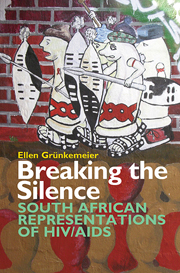7 - Afterword: MEANINGS MATTER
Published online by Cambridge University Press: 05 October 2013
Summary
Playing off the theme ‘Breaking the Silence’ used for the Durban International AIDS Confence in 2000, the focus here has been on texts that address the virus more or less directly, thereby breaking with the pervasive culture of silence that, in turn, also upholds the secrecy and stigma associated with the infection. Functioning as what Jürgen Link calls interdiscourses, the texts reach beyond the purview of expert groups of medical doctors, biologists, sociologists or statisticians in that they circulate knowledge about HIV/AIDS in society as a whole. In so doing, they raise awareness of the infection among South Africans and sustain political efforts to curb the epidemic. Nonetheless, texts do not simply ‘reflect’ and ‘transmit’ realities to a broad public, they also contribute to the cultural construction of the virus. For these reasons, the communication process is not straightforward but involves complex activities of producing, circulating, distributing and consuming meanings. Cultural products are polyvalent and open to various, possibly contradictory readings; therefore, they cannot provide ‘solutions’ but can serve as a starting point by encouraging further debate in the discussion around HIV/AIDS.
These arguments trigger the question about the potential and function of intellectual reflection on the epidemic. Paula Treichler cautions that although HIV/AIDS can be described in terms of its cultural construction, ‘this by no means liberates us from taking responsibility for the existence of the real, material world and analyzing its intersection with our conceptions and interventions’ (Treichler 1999, 175).
- Type
- Chapter
- Information
- Breaking the SilenceSouth African Representations of HIV/AIDS, pp. 221 - 223Publisher: Boydell & BrewerPrint publication year: 2013



